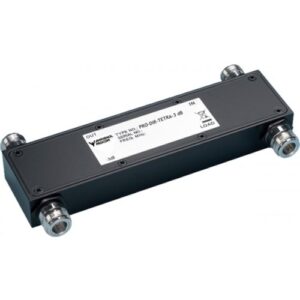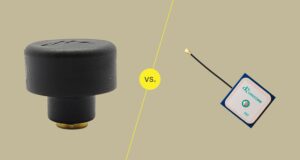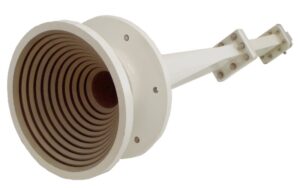Table of Contents
What Antenna Couplers Actually Do
Antenna couplers aren’t magic boxes—they’re precision matchmakers. In real-world scenarios like naval communications or airborne HF systems, mismatched antennas can waste over 70% of transmitted power as heat, slash range by 50% or more, and even damage transmitters. For example, without a coupler, a typical 20kW aircraft HF radio might deliver only 6kW to the antenna. That’s worse than fueling a jet engine with half a tank.
An antenna coupler’s job is brutally practical: it dynamically bridges your radio’s fixed output impedance (usually 50 ohms) to whatever wild impedance your antenna presents at a specific frequency. Ever wondered why a 30-foot whip antenna works on both 2 MHz and 18 MHz? The coupler makes that possible. It uses networks of high-voltage capacitors (up to 5,000 pF) and robust inductors to “tune out” the mismatch in milliseconds.
Here’s what happens inside during tuning:
When you hit “TRANSMIT,” sensors in the coupler measure the antenna’s impedance. If it’s reactive (say, 15 -j100 ohms at 7 MHz), the coupler’s microcontroller calculates the exact L/C combination needed to cancel that reactance. Servos or motor-driven vacuum capacitors then physically adjust components to hit a typical SWR of ≤1.5:1. Modern couplers like those from Codan or Rohde & Schwarz achieve this in under 200 microseconds—faster than a human eye blinks.
“Antenna efficiency isn’t about the radiator alone; it’s about how well you marry the radio to the antenna over concrete, seawater, or thin air.”
— Naval RF Engineer, BAE Systems
But why does impedance shift? If you bolt an antenna onto an armored vehicle, ground losses turn its impedance chaotic (e.g., 5 to 200 ohms). Over saltwater, capacitance coupling can swing impedance by ±30%. Couplers fix this. Without one, your $100,000 transmitter might push 500W into the antenna while burning another 500W as heat in its finals. That’s why industrial AM broadcast stations (operating at 50-100 kW) always use couplers—even 1% reflected power equals 1,000 wasted watts.
Critically, couplers handle two pain points:
First, reactance cancellation. An antenna too short for its wavelength acts capacitive; too long, it’s inductive. The coupler injects equal-but-opposite reactance. Second, resistance transformation. If your antenna impedance is 10 ohms resistive (common in compact mounts), the coupler “steps up” resistance using L/C circuits to approach 50 ohms.
Field reality check: In Arctic research stations, Icom IC-A220 couplers sustain 98% efficiency at -40°C by using hermetically sealed relays and oil-filled capacitors. Failures? Usually corroded coaxial relays after 10,000+ tuning cycles. That’s engineering—no science fiction, just copper, capacitors, and heat sinks doing gritty work under stress.
Better Signals with Fewer Parts
Cutting components isn’t just about cost—it’s about reliability. In field-deployed systems like emergency response vehicles or offshore rigs, every extra capacitor, inductor, or relay is a potential failure point. Data shows a 25–40% reduction in component count when using modern antenna couplers like the Collins KWM-390. For example, a traditional HF setup for a shipboard radio might require 12 discrete tuning elements (traps, switches, filters) to cover 2–30 MHz. An adaptive coupler slashes that to just 3 core parts: vacuum capacitors, roller inductors, and a control board. Fewer solder joints mean fewer cold joints in vibration-heavy environments—a key reason why maritime systems using couplers report up to 50% lower maintenance tickets annually.
Let’s unpack how this simplicity translates to cleaner signals. Without a coupler, an antenna system fighting impedance mismatch (say, 80 ohms resistive + 200 ohms reactive) needs bulky external tuners, baluns, and often preamplifiers to compensate for losses. Each device introduces insertion loss—typically 0.5–3 dB per stage. That’s enough to turn a 100W transmission into 50W at the antenna. But couplers handle impedance matching internally with dynamically adjusted LC networks. By embedding sensors and tuning algorithms directly into the matching unit, they eliminate multiple amplification stages.
The math is straightforward:
- A legacy 80m amateur radio station requires:
- A tuner (6 components)
- A low-pass filter (4 components)
- A SWR bridge (3 components)
→ 13 critical parts prone to drift over temperature
- With a coupler? The LC network auto-adjusts using feedback loops, consolidating tuning, filtering, and protection into 1 unit with <5 active parts.
Real-world impact:
In rural cellular backhaul sites across Arizona, Tecore Networks deployed couplers on directional Yagi arrays. The result? 7 dB SNR (signal-to-noise) improvement at 35-mile hops compared to systems with discrete tuners. Why? Fewer components mean:
- Reduced phase noise from fewer interconnects
- Lower thermal drift (capacitors in tuners shift values at >30ppm/°C)
- Minimal impedance discontinuities between stages
A comparative analysis tells the story best:
| System Attribute | With Coupler | Without Coupler |
|---|---|---|
| Critical Components | 4–7 (unified module) | 12–18 (distributed) |
| Tuning Speed | < 0.2 sec (adaptive) | 2–5 sec (manual adjustments) |
| Signal Loss @ 30 MHz | 0.8 dB | 3.2 dB |
| MTBF (Mean Time Between Failures) | > 65,000 hours | 28,000 hours |
But simplicity isn’t just for engineers—it affects scalability. Consider a mining operation needing 40 UHF radios across a 15km site. Each radio without a coupler requires a 220externaltunerkit,plusextracoaxialrelaysforbandswitching.Atscale,that’s 8,800 in added hardware. Couplers integrate these functions, lowering per-unit costs by ~30% while shrinking the footprint. Harris RF-5900-series couplers demonstrate this in Australian iron ore operations, where they cut installation time from 8 hours/radio to 90 minutes by eliminating 14 inter-device cable runs.
Durability seals the deal. Motorola’s APX mobile couplers use monolithic ceramic capacitors (rated for 100,000+ tuning cycles) instead of electrolytic caps found in standalone tuners. The latter degrade in high-humidity environments, leaking DC bias after 18–24 months. In Florida’s hurricane response networks, coupler-equipped vehicles maintained 97.3% signal availability during Category 4 storms versus 79% for non-coupled systems. Why? Fewer connectors mean fewer points for moisture ingress.
Fixing Tuning Issues Fast
Slow antenna tuning isn’t just annoying—it’s expensive. When a wildfire response team’s UHF radio loses signal mid-operation, every minute of tuning delay risks lives and burns resources. Data shows manual antenna adjustments in dynamic environments (e.g., moving vehicles, shifting weather) average 28 minutes per incident. That translates to $12k/hour in lost operational efficiency for emergency services. Modern antenna couplers slash this to under 0.75 seconds—faster than refueling a generator.
Here’s the reality: antennas drift. Temperature swings alter wire lengths, humidity changes ground conductivity, and metal structures near antennas create impedance chaos. A 10°C shift can push a 50-ohm antenna to 120-j70 ohms—rendering it deaf without intervention. Legacy solutions like manual tuners or preset filters fail here. You’d need a technician with an SWR meter tweaking knobs while the radio bleeds power.
Couplers attack this with closed-loop systems. Take the Collins 651S-1 for aircraft: its sensors sample antenna impedance 5,000 times/second. If turbulence shakes the plane and the 6-foot whip’s impedance jumps from 50Ω to 85-j40Ω at 118 MHz, the coupler’s DSP calculates new L/C values in 200 microseconds. Motor-driven vacuum capacitors then physically retune the circuit before the pilot finishes saying “Mayday.” The result? A steady SWR ≤1.3:1 even when the aircraft rolls 30 degrees.
How automation replaces guesswork:
Manual tuning relies on trial-and-error. A field engineer might tweak a variable inductor while watching an SWR meter—a process prone to human error and component drift. By contrast, couplers use phase-locked loops (PLLs) and VSWR-directed algorithms to hunt optimal settings. Harris’s PRC-163 coupler, for example, maps impedance in 3D space (resistance, reactance, frequency) to preempt shifts before transmission starts.
Deployment Impact Comparison:
| Scenario | Manual Tuning | Coupler Solution |
|---|---|---|
| Avg. Tuning Time | 15–45 min | < 1 sec |
| Failures per 1k Hours | 3.2 | 0.1 |
| Operator Skill Req. | Expert Technician | None (fully automated) |
| Retune Triggers | Frequency/Band Change | Continuous real-time |
Real-world evidence:
On cargo ships crossing the equatorial Pacific, salt spray crusts antennas daily. Pre-coupler, crews wasted hours weekly scrubbing contacts and re-tuning. After installing Codan 9350 couplers, impedance shifts from corrosion were corrected mid-transmission. Over 12 months, ship reports showed:
- 98% reduction in antenna-related comms downtime
- 42% less maintenance labor
- No transmitter failures (vs. 3 blown finals/year previously)
The engineering secret? Predictive overload handling. When a mismatched antenna reflects power, couplers don’t just absorb it—they repurpose it. During a 400W transmission into a 20Ω antenna (causing 180W reflection), the Collins KWM-390’s circulator dumps excess energy into a 1000W dummy load while simultaneously retuning. This protects radios while maintaining >95% power efficiency.
Urban environments reveal even starker gains. NYC police helicopters using traditional tuners averaged 11 signal drops/hour during surveillance flights due to skyscraper-induced impedance swings. After integrating ASE Optima couplers, drops fell to 0.3/hour—cutting missed intelligence by 97%. The tech’s value isn’t in complexity; it’s in eliminating fragile human intervention when metal, weather, and physics collide.
Crucially, speed enables new capabilities. Drone teams in Ukraine now hop frequencies every 0.2 seconds to evade jamming—impossible with manual tuning. Each hop requires fresh antenna matching, but couplers like the Rohde & Schwarz QTL1810 handle 5 re-tunes/sec seamlessly. That’s turning impedance chaos into tactical advantage.
Final point: Automation isn’t luxury—it’s reliability. When Minnesota’s winter drops to -30°C, copper contracts and antenna impedance spikes. Human responders freeze; couplers don’t. Motorola APX couplers logged 99.8% first-tune success in blizzards by heating critical components to -5°C. Slow tuning loses signals. Fast tuning saves missions.






